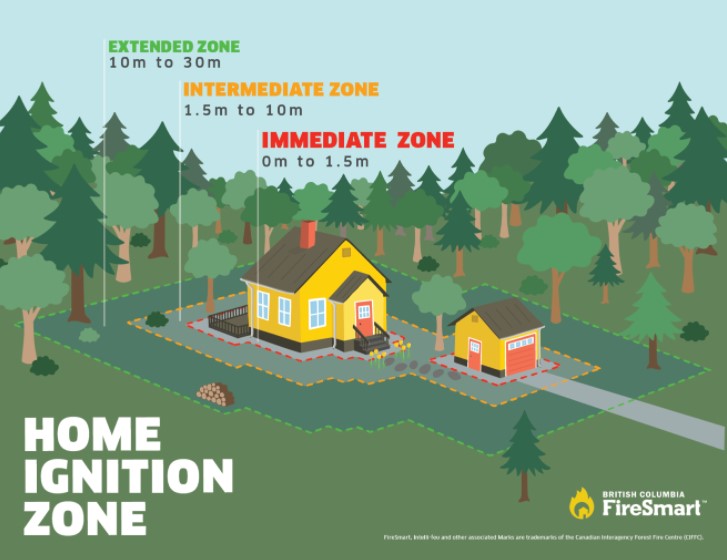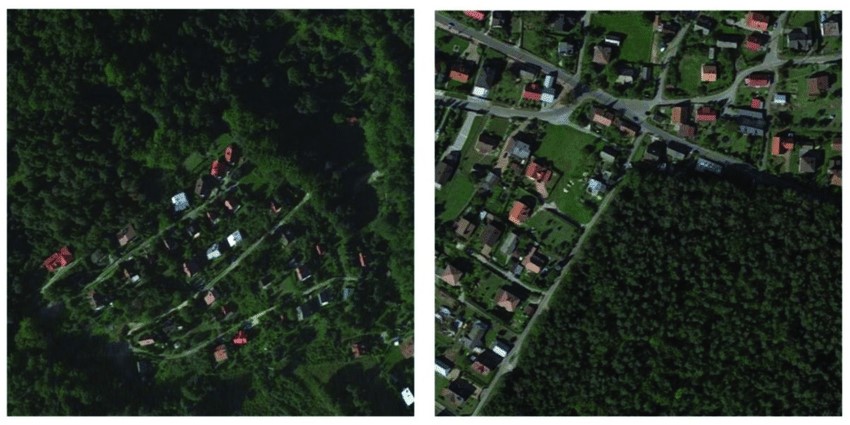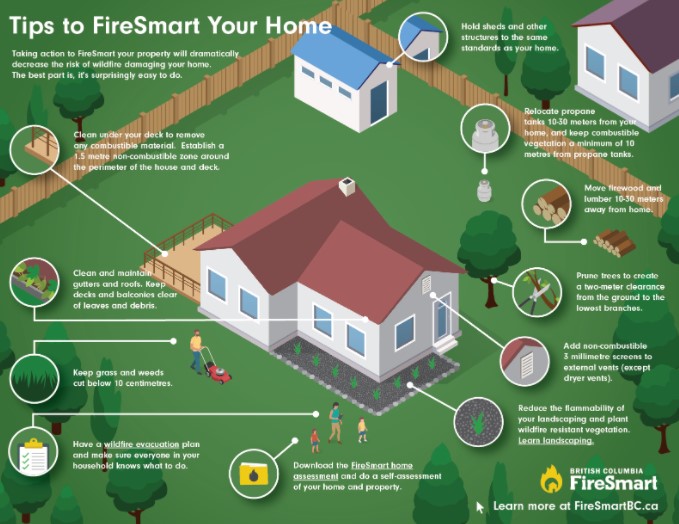
What is FireSmart?
FireSmart is a national, provincial, and municipal initiative that helps property owners and communities understand how wildfires can threaten structures located in or near forested and wildland areas. It also outlines practical steps individuals and communities can take to reduce the vulnerability of buildings and property to fire.
Examples of FireSmart practices include:
- Remove piles of firewood, building materials, tires, and other flammable items from within 10 meters of homes and structures.
- Keep track of your firewood consumption, each fall place that amount in an accessible location for you to utilize and plan to relocate the remaining wood when the spring returns.
- Clear or properly space all plants and vegetation within 10 meters of buildings. When planting new trees, consider fire-resistant deciduous species such as birch and aspen. Refer to the FireSmart BC Landscaping Guide for guidance on what types of plants do and do not belong! More information here.
- Ensure trees and vegetation do not overhang the roof, and keep gutters well-maintained and free of debris.
As homeowners, we can all take simple yet effective steps to increase our resilience and reduce the impact of wildfire on our properties and within our communities. Click here for more information.
“The Test” is the story of the town of Logan Lake's efforts to make their community more fire resilient, eventually becoming the first FireSmart community in Canada. But when the 2021 Tremont Creek Wildfire roared toward them, all eyes were on the little community as nobody knew if all of that work would pay off and if they would pass the test.

Click on the picture below to watch a short video about FireSmart and You!
Begin your FireSmart journey here:
FireSmart 101:
- FireSmart 101 is a free, one-hour course offered by FireSmart Canada that empowers residents to take action. Test your knowledge and gain valuable insights into protecting your home and neighborhood from wildfire.
Wildfire Risk Reduction Course:
- FireSmart BC's Wildfire Risk Reduction course is for non-forest professionals who are interested in wildfire risk reduction, or are engaged in FireSmart BC programs. The course will introduce you to the key concepts, players, risk reduction strategies, and funding opportunities that help to minimize the negative impacts of wildfires in our province.
Keep your eyes open for available course offerings and become a Local FireSmart Representative!
Community Wildfire Resiliency Plan (CWRP)
The Community Wildfire Resiliency Plan (CWRP) helps Tumbler Ridge reduce wildfire risks and build a safer, FireSmart community. Focusing on the townsite and the Industrial Park, the plan identifies areas most at risk, including the wildland-urban interface, and outlines actions to increase resiliency.
Developed by the District of Tumbler Ridge's Protective Services with support from regional experts, the CWRP is funded through the provincial Community Resiliency Investment program.
Alongside the plan, an Action Plan provides clear steps for reducing risk, including:
- Protecting critical infrastructure and greenspaces
- Supporting FireSmart development and landscaping
- Offering education and resident support programs
- Training staff for wildfire responses
- Managing vegetation to reduce fire severity
As wildfire risks evolve due to climate change, forest health, and industrial activity, this plan ensures Tumbler Ridge remains prepared and resilient for the future.
Review the District of Tumbler Ridge's current Community Wildfire Resiliency Plan here.
What is the Wildland – Urban Interface? (WUI or “WOO-HEE”)
The Wildland–Urban Interface (WUI) is the zone where human development—such as homes, structures, and infrastructure—meets or intermingles with undeveloped forested land and natural vegetation.
The WUI is more than just a geographic boundary. It represents a complex relationship between environmental conditions, community development, and economic and social factors—all of which influence how wildfire risk is managed in these areas.
The WUI is broken down further into two sub-categories, Interface & Intermix; some areas of Tumbler Ridge fall into each of these categories.
Interface is when there is a clear line of demarcation between residential, business, and public structures and wildland fuels; in these areas, wildland fuels do not generally continue into the developed area.
Intermix is when there is no clear line of demarcation; in these areas, wildland fuels are continuous outside of and within the developed area.

As a wildfire approaches a community, it is initially fueled by forested land and vegetation. When the fire enters the wildland-urban interface (WUI) and begins to compromise structures, the fire reaches a critical transition period. During this time, the fire shifts from consuming natural vegetation and wildland fuels to burning “built fuels” such as homes, fences, and other infrastructure within the community.
At this point, these fires are no longer considered wildfires in the traditional sense. Instead, they evolve into urban conflagrations, spreading from structure to structure through radiant heat, embers, and direct flame contact. This is where FireSmart practices can play a crucial role—often becoming the deciding factor in slowing or stopping the spread of the blaze.
To learn more about wildfire behavior, how fires spread in the WUI, and the steps you and your neighborhood can take to reduce wildfire impacts, refer to the FireSmart BC Begins At Home Guide.
Additional Resources:
For more information about FireSmart overall, check out the FireSmart BC website and FireSmart BC - YouTube .
The FireSmart BC Begins At Home Guide and the FireSmart BC Landscaping Guide | FireSmart BC provides individuals with recommendations for them to take meaningful steps to help reduce the risk of wildfires to their own homes and neighborhoods and create a more resilient community around us.
Don't forget to check out:
Have Questions? Contact Us!
Brian Robinson
FireSmart Coordinator
Phone: 250-242-3939
Email: Email
